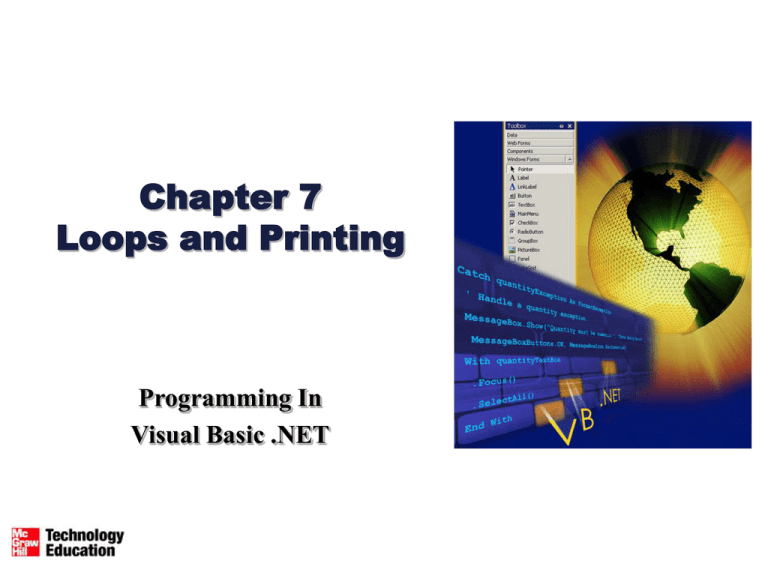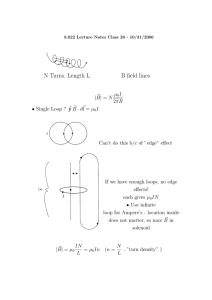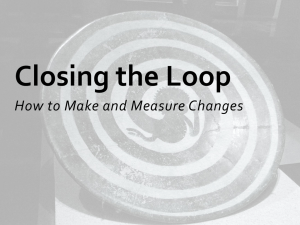
Chapter 7
Loops and Printing
Programming In
Visual Basic .NET
Do/Loops
• Repeating a series of instructions
• An iteration is a single execution of the statement(s) in the
loop
• Used when the exact number of iterations is unknown
7- 2
© 2005 by The McGraw-Hill Companies, Inc. All rights reserved.
Do/Loops (continued)
• Terminates based on a specified condition
– Loop While a condition is True
– Loop Until a condition becomes True
• Condition can be placed at
– Top of loop - Pretest
– Bottom of loop - Posttest
7- 3
© 2005 by The McGraw-Hill Companies, Inc. All rights reserved.
The Do and Loop Statements General Form
Do {While |Until} condition
' Statements in loop.
Loop
OR
Do
' Statements in loop.
Loop {While | Until} condition
7- 4
Top of Loop
Condition,
Pretest
(condition
checked
before the
loop exectures
Bottom of
Loop Condition,
Posttest
(condition
checked after
the loop
executes)
© 2005 by The McGraw-Hill Companies, Inc. All rights reserved.
Pretest vs. Posttest
• Pretest, loop may never be executed since tested BEFORE
running
• Do While … Loop
• Do Until … Loop
• Posttest, loop will always be executed at least once
• Do … Loop While
• Do … Loop Until
7- 5
© 2005 by The McGraw-Hill Companies, Inc. All rights reserved.
Do While vs. Do Until
• Do While a condition is true or false
Loop
userEntry = False
Do while errorFlag = False
…
If len(customerName.textbox) > 0 Then
…
userEntry = True
Else
…
End If
Loop
7- 6
Condition
False
True
Condition
False
True
© 2005 by The McGraw-Hill Companies, Inc. All rights reserved.
Do While vs. Do Until: Pretest
• Do While a condition is true or false
Loop
userEntry = False
Do until errorFlag = True
…
If len(customerName.textbox) > 0 Then
…
userEntry = True
Else
…
End If
Loop
7- 7
Condition
True
False
Condition
False
True
© 2005 by The McGraw-Hill Companies, Inc. All rights reserved.
Do While vs. Do Until: Posttest
• Do While a condition is true or false
Loop
userEntry = True
Do
…
False
Condition
If len(customerName.textbox) > 0 Then
…
True
userEntry = True
userEntry
Else
= True
…
End If
Loop Until userEntry = True
Condition
False
(or Loop While userEntry = False)
True
7- 8
© 2005 by The McGraw-Hill Companies, Inc. All rights reserved.
For/Next Loops
• Use when you know the number of iterations
• Uses a numeric counter variable, called Loop Index, to
control number of iterations
• Loop Index is incremented at the bottom of the loop on
each iteration
• Step value can be included to specify the incrementing
amount to increment Loop Index, step can be a negative
number
7- 9
© 2005 by The McGraw-Hill Companies, Inc. All rights reserved.
The For and Next Statements General Form
For LoopIndex = InitialValue To TestValue [Step Increment]
' Statements in loop.
Next [LoopIndex]
7- 10
© 2005 by The McGraw-Hill Companies, Inc. All rights reserved.
For/Next Loop
• For example:
Dim customerCount as Integer
For customerCount = 1 to 10
...
If customerType = “Regular” Then
…
Else
End If
Next
7- 11
© 2005 by The McGraw-Hill Companies, Inc. All rights reserved.
Exiting For/Next Loops
• In some situations you may need to exit the loop
prematurely
• Use the Exit For statement inside the loop structure
• Generally the Exit For statement is part of an If statement
7- 12
© 2005 by The McGraw-Hill Companies, Inc. All rights reserved.
The PrintDocument Component
• Add a PrintDocument component to form
– Appears in the Component Tray
• Execute the Print method to start printing
• Logic for actual printing belongs in the PrintDocument's
PrintPage event procedure
7- 13
© 2005 by The McGraw-Hill Companies, Inc. All rights reserved.
Setting Up the Print Output
• PrintPage event is fired once for each page to be printed,
referred to as callback
• BeginPrint and EndPrint are also fired at the beginning and
end of the printing
• PrintPage event includes the argument e as
System.Drawing.Printing.PrintPageEventArgs
• Properties of the PrintPageEventArgs are useful for
handling page margins and sending strings of text to the
page
7- 14
© 2005 by The McGraw-Hill Companies, Inc. All rights reserved.
The Graphics Page
• Set up graphics page in memory and then page is sent to
the printer
• Can contain strings of text and graphic elements
• Specify the exact X and Y coordinates of each element to
be printed on the page
7- 15
© 2005 by The McGraw-Hill Companies, Inc. All rights reserved.
Using the DrawString Method
• Used to send a line of text to the graphics page
• Belongs to the Graphics object of the PrintPageEventArgs
argument
• Is an overloaded method so there are several forms for
calling the method
• Set up the Font to be used before executing the DrawString
method
7- 16
© 2005 by The McGraw-Hill Companies, Inc. All rights reserved.
The DrawString Method (cont)
General Form
DrawString(StringToPrint, Font, Brush, Xcoordinate, Ycoordinate)
Examples
e.Graphics.DrawString(printLineString, printFont, Brushes.Black, _
horizontalPrintLocationSingle, verticalPrintLocationSingle)
e.Graphics.DrawString("My text string", myFont, Brushes.Black, _
100.0, 100.0)
e.Graphics.DrawString(nameTextBox.Text, New Font("Arial", 10), _
Brushes.Red, leftMarginSingle, currentLineSingle)
7- 17
© 2005 by The McGraw-Hill Companies, Inc. All rights reserved.
Setting the X and Y Coordinates
• For each print line, specify X and Y coordinates
• Create variables declared as Single to set the X and Y
values
7- 18
© 2005 by The McGraw-Hill Companies, Inc. All rights reserved.
PrintPageEventArgs
• PrintPageEventArgs argument has several useful properties
• MarginBounds
– Code as
• e.MarginBounds.Left
• e.MarginBounds.Right
• e.MarginBounds.Top
• e.MarginBounds.Bottom
• PageBounds
• PageSettings
7- 19
© 2005 by The McGraw-Hill Companies, Inc. All rights reserved.
Aligning Decimal Columns
•
•
•
•
7- 20
It is important to align the decimal points of numeric data
Proportional fonts make aligning decimal points difficult
Declare an object as a SizeF Structure
Use MeasureString method of the Graphics class to
determine the width of a formatted string in pixels
© 2005 by The McGraw-Hill Companies, Inc. All rights reserved.
Aligning Decimal Columns
Code Example
' SizeF structure for font size info.
Dim fontSizeF As New SizeF( )
' Set X for left-aligned column.
horizontalPrintLocationSingle = 200
' Set ending position for right-aligned column.
columnEndSingle = 500
' Format the number.
formattedOutputString= amountDecimal.ToString("C")
' Calculate the X position of the amount.
' Measure string in this font.
fontSizeF= e.Graphics.MeasureString(formattedOutputString, _
printFont)
7- 21
© 2005 by The McGraw-Hill Companies, Inc. All rights reserved.
Aligning Decimal Columns
Code Example (cont)
' SizeF structure for font size info (cont).
' Subtract width of string from the column position.
columnXSingle = columnEndSingle - fontSizeF.Width
' Set up the line--each element separately.
e.Graphics.DrawString("The Amount = ", printFont, _
Brushes.Black, horizontalPrintLocationSingle, _
verticalPrintLocationSingle)
e.Graphics.DrawString(formattedOutputString, printFont, _
Brushes.Black, columnXSingle, verticalPrintLocationSingle)
' Increment line for next line.
verticalPrintLocationSingle += lineHeightSingle
7- 22
© 2005 by The McGraw-Hill Companies, Inc. All rights reserved.
Displaying a Print Preview
• Add PrintPreviewDialog
component to form
– Appears in the Component Tray
– Default name is fine
• Assign in code the same PrintDocument object you are
using for printing
• Execute the ShowDialog method of the
PrintPreviewDialog component
7- 23
© 2005 by The McGraw-Hill Companies, Inc. All rights reserved.
Using Static Variables
• Static local variables retain their value for the life of the
project
• Can be useful for
– Running totals
– Running counts
– Boolean switches
– Storing current page number/count when printing
multiple pages
7- 24
© 2005 by The McGraw-Hill Companies, Inc. All rights reserved.
Printing Multiple Pages
• Recall that the PrintDocument's PrintPage event fires once
for each page
• Indicate that there are more pages to print by setting the
HasMorePages property of the PrintPageEventArgs to True
7- 25
© 2005 by The McGraw-Hill Companies, Inc. All rights reserved.




